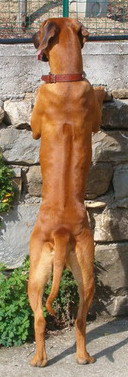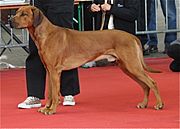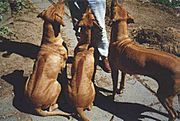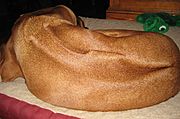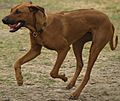Rhodesian Ridgeback facts for kids
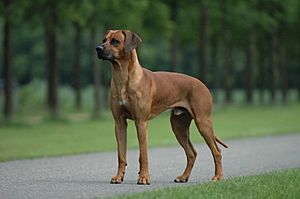
Black nose Rhodesian Ridgeback
|
||||||||||||||||||||||||||
| Other names | African Lion Dog African Lion Hound |
|||||||||||||||||||||||||
|---|---|---|---|---|---|---|---|---|---|---|---|---|---|---|---|---|---|---|---|---|---|---|---|---|---|---|
| Origin | Rhodesia/Southern Rhodesia (Now Zimbabwe) | |||||||||||||||||||||||||
|
||||||||||||||||||||||||||
| Domestic dog (Canis lupus familiaris) | ||||||||||||||||||||||||||
Rhodesian Ridgeback is a breed of dog.
It has a red-brown coat of fur on its body and a line of hair down its back which is different from the rest of hair on its body. They are sometimes called The African Lion Dog, because they were used by hunters in Africa to sniff out and confuse lions while the hunter shot the lion.
Description
Appearance
The Rhodesian Ridgeback's distinguishing feature is the ridge of hair running along its back in the opposite direction from the rest of its coat. It consists of a fan-like area formed by two whorls of hair (called "crowns") and tapers from immediately behind the shoulders down to the level of the hips. The ridge is usually about 2 inches (51 mm) in width at its widest point. It is believed to originate from the dog used by the original African dog population which had a similar ridge. The first depiction of a ridgeback is a wall painting describing the life of the Boers, housed in South Africa in the Voortrekker Monument.
Male ridgebacks usually stand 25–27 in (64–69 cm) at the withers and weigh about 36.5 kg (80 lb) (FCI standard); females are typically 24–26 inches (61–66 cm) tall and about 32 kg (71 lb) in weight. Ridgebacks are typically muscular and have a light wheaten to red wheaten coat, which should be short, dense, sleek and glossy in appearance, and neither woolly nor silky.
White is acceptable on the chest and toes. The presence of black guard hairs or ticking is not addressed in the AKC standard, although the elaboration of the AKC standard notes the amount of black or dark brown in the coat should not be excessive. The FCI standard states that excessive black hairs throughout the coat are highly undesirable. Ridgebacks sometimes have a dark mask. The dog's nose should be black or liver in keeping with the colour of the dog. No other coloured nose is permissible. The brown nose is a recessive gene. It is not as common as a black nose; some breeders believe the inclusion of brown noses in a breeding program is necessary for maintaining the vibrancy of the coat. The eyes should be round and should reflect the dog's colour: dark eyes with a black nose, amber eyes with a brown (liver) nose. Ridgebacks have a strong, smooth tail, which is usually carried in a gentle curve backwards.
The original standard allowed for a variety of coat colours, including brindle and sable. The modern FCI standard calls for light wheaten to red wheaten.
Other dog breeds also have a reverse line of fur along the spine, including the Phu Quoc ridgeback dog and Thai ridgeback. The Thai ridgeback is a crossbreed of the Phu Quoc; historians have speculated the relationship between the Rhodesian Ridgeback and the Phu Quoc with suggestions that historically one breed may have been imported to the other's location.
Temperament
Rhodesian Ridgebacks are known to be loyal and intelligent. They are typically somewhat aloof to strangers; this is not to be confused with aggression, a Rhodesian Ridgeback with a good temperament will not attack a stranger for no reason. They require consistent training and correct socialization; they are often not the best choice for inexperienced dog owners. Rhodesian Ridgebacks are strong-willed and confident dogs. They are protective of their owners and families; if trained well, they can be excellent guard dogs.
Despite Rhodesian Ridgebacks being extremely athletic and sometimes imposing, they do have a sensitive side. Francis R. Barnes, who wrote the first standard in 1922, acknowledged that, "rough treatment ... should never be administered to these dogs, especially when they are young. They go to pieces with handling of that kind." The Rhodesian Ridgeback accepts correction as long as it is fair and justified, and as long as it comes from someone the dog knows and trusts.
Images for kids
See also
 In Spanish: Perro crestado rodesiano para niños
In Spanish: Perro crestado rodesiano para niños


